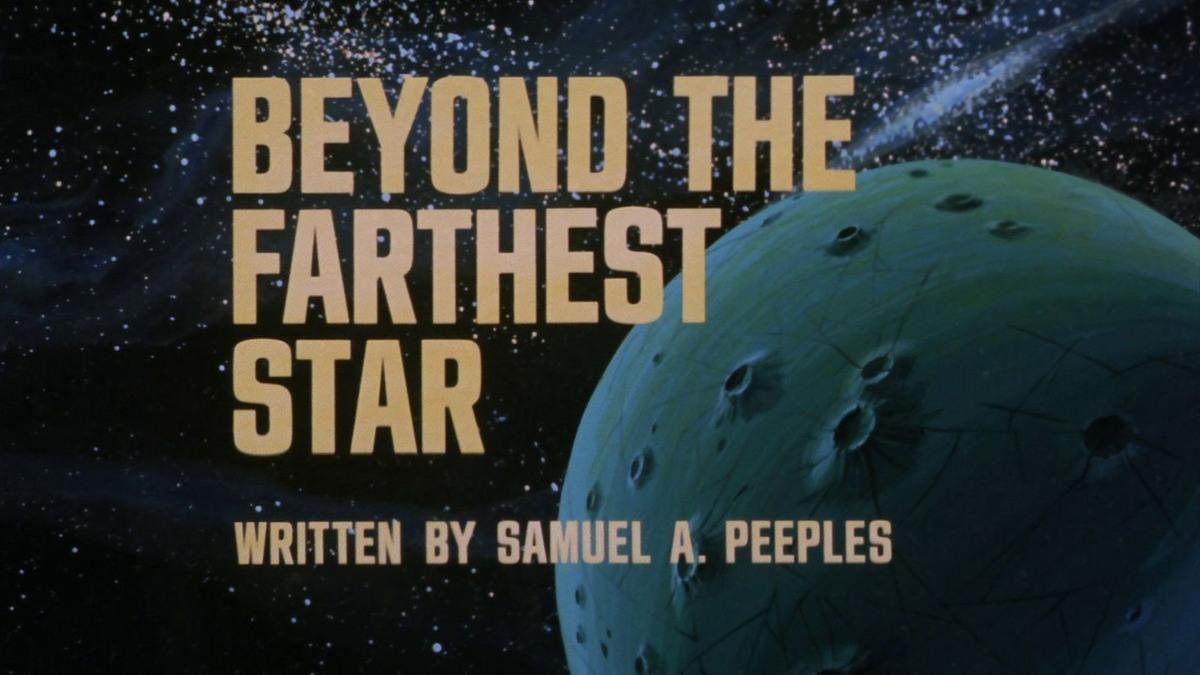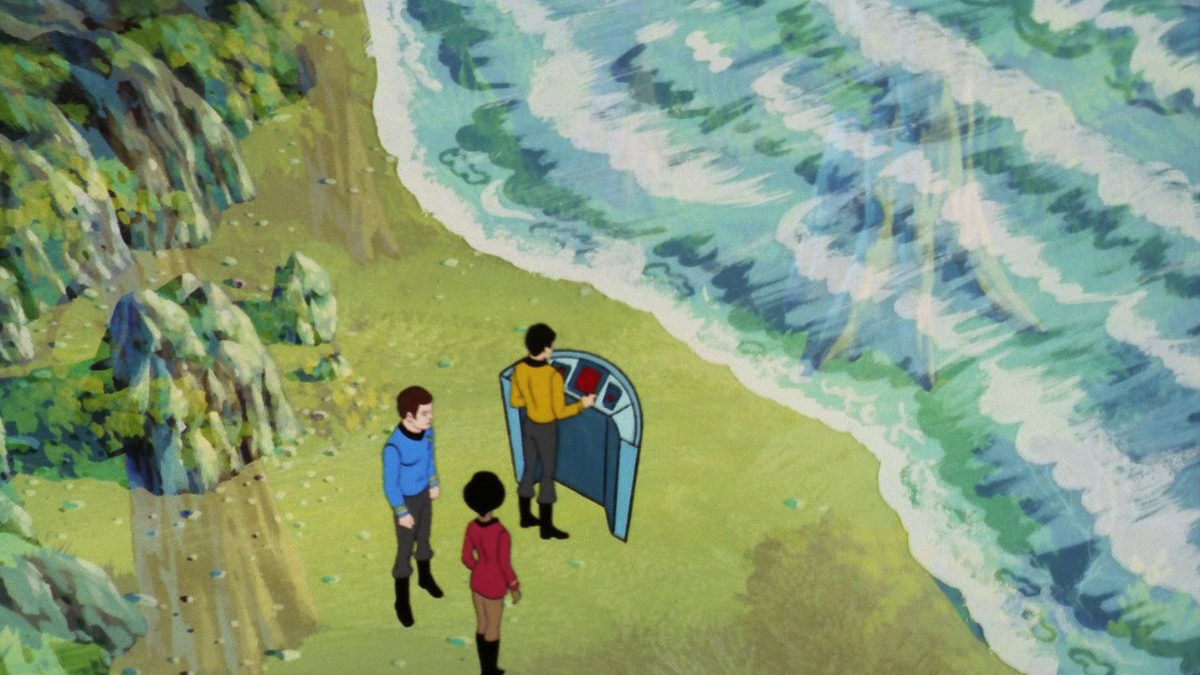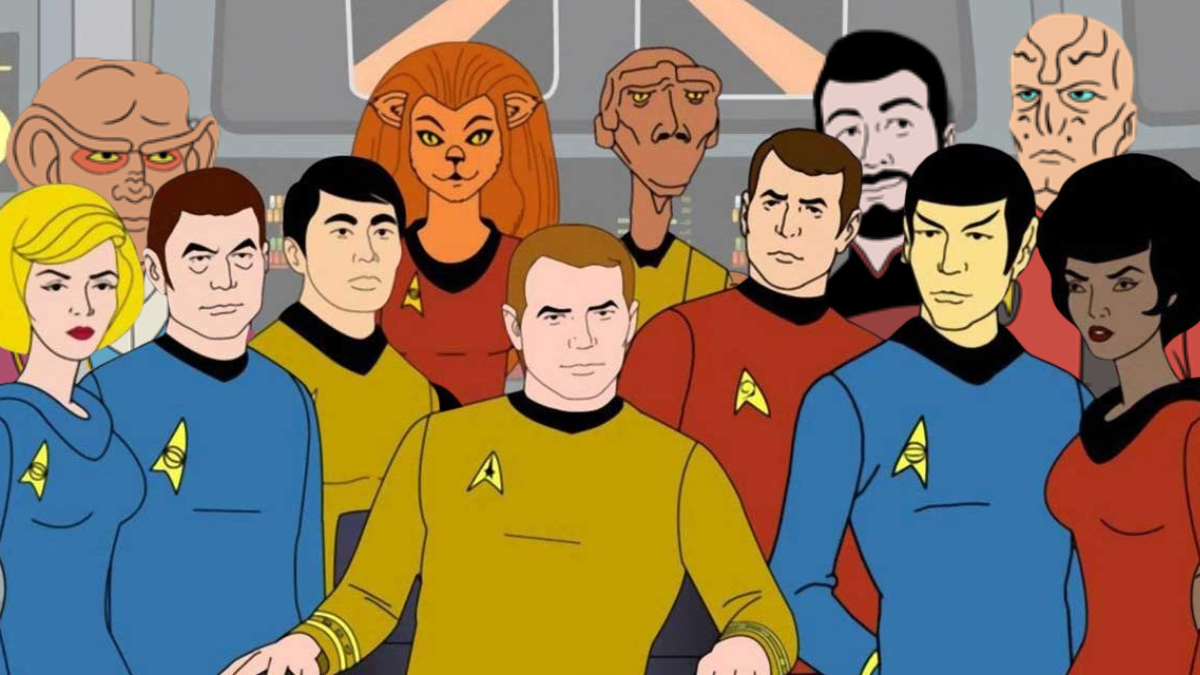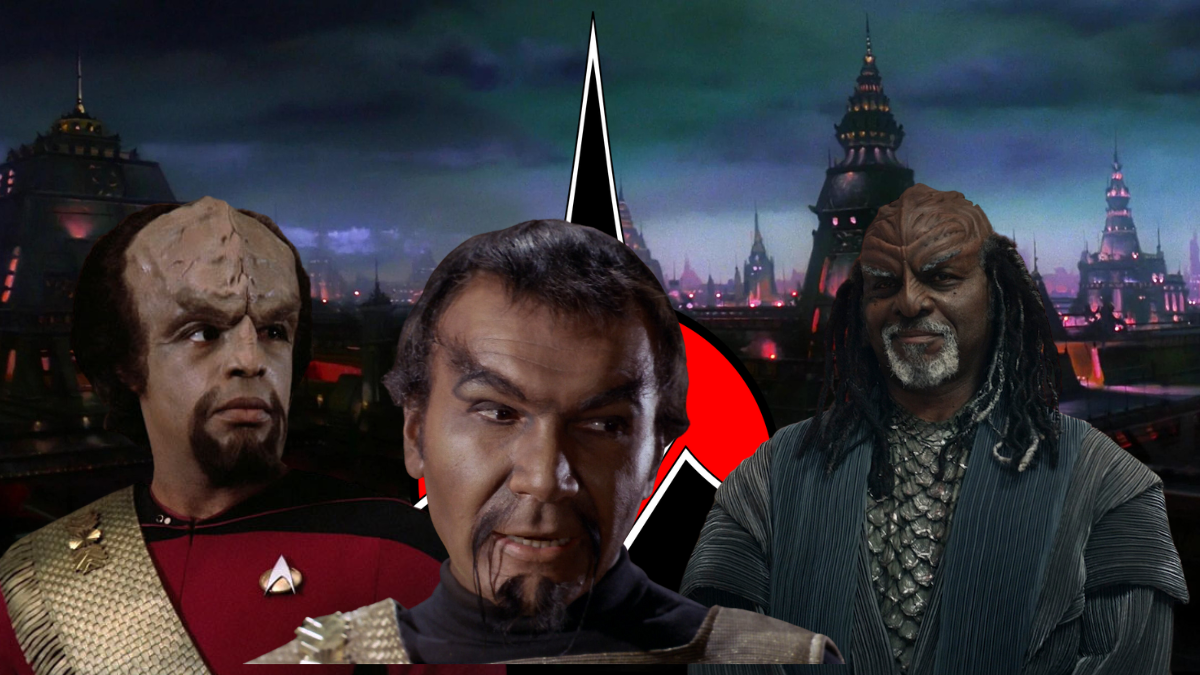REWATCH: Celebrate 50 Years of 'Star Trek: The Animated Series' By Watching "Beyond the Farthest Star"

Image: Paramount.
SEPTEMBER 8, 2023 - Today is Star Trek Day, Trekkies’ answer to Star Wars’ May the Fourth, when we celebrate the premiere of Star Trek: The Original Series (TOS) with the episode “The Man Trap.” But many people forget that Star Trek: The Animated Series (TAS) also premiered on September 8, just seven years after TOS was first seen by the public.
TAS, like its predecessor, was originally called simply Star Trek, and series creator Gene Roddenberry and showrunner Dorothy “DC” Fontana treated it as a true Trek, despite Roddenberry’s insistence in later years that it wasn’t canon. It’s ironic that this year we celebrate the show’s 50th anniversary as Hollywood is going through a writers’ strike, since it’s because of another Writers Guild of America (WGA) strike, this one in 1973, that we got such high-quality scripts from TAS. A loophole in the WGA contract allowed excellent writers like Samuel Peeples (who penned the script for TOS’ second pilot, “Where No Man Has Gone Before”) to write for animation.
We at DSTN don’t want to be left out of the 50th anniversary celebration, so we thought it would be fitting to rewatch the pilot episode of TAS. We wanted to honor the series by watching the first episode, which appeared in most of the United States on September 8, 1973. If you haven’t seen the episodes (or haven’t seen them in a while) you. might want to watch them before you read the rest of this article. Also, we used Aaron Harvey and Rich Schepis’ excellent Star Trek: The Official Guide to the Animated Series for much of our research, so if it’s not on your bookshelf, head on over to Amazon and order it for yourself!
Act I
While on a star-charting mission, the Enterprise is pulled into orbit of Questar M-17, a dead star on the fringe of the Milky Way. It’s not long before they encounter a mysterious, not to mention enormous, starship nearby. The ship, which appears to be 300 million years old, is emitting a strange radio signal, despite the fact that it is severely damaged and as dead as the star below.
A landing party consisting of Kirk (William Shatner), Spock (Leonard Nimay), McCoy (DeForest Kelley), and Scott (James Doohan) beams aboard the ancient vessel to get some answers. While our heroes are immediately impressed by the ship’s construction, the question remains. What destroyed her? Spock’s startling hypothesis: the ship’s crew destroyed her themselves…
Being a 1970s Saturday morning cartoon, this show doesn’t have a “teaser,” what we would call a “cold open” today. Instead, the first thing kids tuning in on September 8, 1973, saw were stars. Appropriate for a series with that word in the title. The opening theme, composed by jazz legend Ray Ellis, evokes the feeling of Alexander Courage’s TOS theme without lifting it wholesale. Coupled with visuals of the Enterprise flying through space, revealing the top cast credits really ties the two shows together and leaves no doubt that animated or not, this is Star Trekl. (An interesting side note: Ellis’ day job at a music publishing company prohibited him from taking credit for the music. Instead, he hid behind two names, a double nom de compositeur, if you will: “Yvette Blais,” his wife’s maiden name, and “Jeff Michael,” the sons of Producer Norm Prescott.)
It must have been a pleasure for adult Trek fans, who had been bereft of Star Trek for four long years, to revisit the bridge of the ship and hear the voices of Shatner, Nimoy, Kelley, Doohan, George Takei (Sulu), and Nichelle Nichols (Uhura) once again. The story, while moving along quicker, perhaps, than a TOS episode’s (it is, after all, a good 25 minutes shorter than its predecessor’s typical running time) and a little more simplistic, is worthy of the Star Trek name, too.
What has come to be known as “technobabble” exists here, too, especially prevalent as Spock and Scotty admire the alien ship’s design and exotic materials. There are new Starfleet technologies, as well. The members of the away team wear life support belts instead of environmental suits, ironically to save money. Drawing a glowing line around the characters, an effect that would have been more costly on the live-action series, was much cheaper in animation than drawing the bulky suits designed by William Ware Theiss for TOS.
There were some great callbacks to episodes of TOS, too. Early on, when they find themselves trapped in the star’s orbit, Kirk suggests they use the “slingshot effect” to pry themselves loose. You know, the same slingshot effect that flung them back in time 400 years in the episode “Tomorrow Is Yesterday.” (Star Trek made this concept famous, but it’s a real-world concept, usually referred to as “gravity assist,” which was theorized as early as 1918 and first attempted in 1959 by the Soviets.)
I watched this episode with my 11-year-old niece Lydia and my 5-year-old nephew Rhys. Rhys was at first uninterested, preferring to play a Star Wars game on my iPad, but about a minute and a half in, he turned off the game and began watching with rapt attention, proclaiming, “I don’t want to play the game anymore. This is too interesting!” (Take that, Star Wars!)
Act II
The away team continues to explore and admire the strange alien vessel, but after a while, they begin to feel as if they’re being watched. The ever-logical Vulcan, Spock, writes it off as “latent, primal superstition. The fear of primitive people confronting something unknown to them.”
“Compared to the people that built this ship, we are primitive, even you, Mr. Spock,” Kirk snaps back.
Our heroes make their way deeper into the ship, ultimately finding themselves trapped in what may be the ship’s bridge, with some kind of interference making their communicators useless. It’s not long before they locate the source of the interference, a jerry-rigged piece of machinery, apparently built to shield the room from something. But what?
The answer to that question may be closer than they realize, as something starts to try to break into the room like the Big Bad Wolf huffing and puffing against the third little pig’s brick house. At that moment, a nearby monitor comes alive, with a strange-looking purple alien fading onto the screen to deliver a 300 million-year-old message.
“Danger! Danger!” the ancient voice declares. The dead star, it seems, is a trap, pulling starships in and allowing a malevolent alien who’s been trapped there a chance to escape. Rather than give it the chance, the crew decided to destroy their own vessel.
The message barely has time to finish before the alien force manages to blast its way into the room, ending the interference and allowing the Enterprise to beam its away team back. Unfortunately, they aren’t the only ones to transport; beside Kirk on the transporter pad is an amorphous green lifeform (James Doohan)! Before it can be beamed elsewhere, it makes its way into the ship’s systems with a maniacal laugh…
One of the advantages of animation was the ability to create alien environments that looked truly alien. One of Roddenberry’s goals was reportedly to have a volcano on the show because he couldn’t do that in live-action. He would eventually get his wish, but not in this episode. The alien ship, however, was a good example of how animation could be used to elevate a story. One would never have seen such a vessel in TOS because a television budget, which the Star Trek team was already stretching past its breaking point, wouldn’t have covered it.
This section of the show turns the “creepy factor” up to 10, too. When McCoy and Scotty sense that they’re being watched, you believe them, despite Spock’s offhanded dismissal. And when they enter the bridge, the music helps add some tension to the scene. If I found it to be creepy, my young nephew found it doubly so. It was when the away team found themselves trapped that Rhys leaped up and hid behind his chair, peering out so he didn’t miss a minute. Even though he found it scary, he couldn’t take his eyes off it.
Once the crew was back in the familiar territory of the Enterprise’s transporter room, he cautiously came out from hiding, sitting near me in case there were other scares on the horizon.
Act III
With an unknown alien playing hide-and-seek inside the Enterprise, Kirk and company prepare to defend themselves. Spock activates the Automatic Bridge Defense System (BDS) and Kirk sends Scotty to Engineering to arm the self-destruct system.
The alien, though, has other plans. It traps Scotty in a hatchway and freezes the controls in an attempt to crush him to death. No sooner do they get the Engineer free than it takes control of the ship’s phasers and disintegrates the ancient alien ship, then takes complete control of the Enterprise.
By now, the alien’s motives are clear. The powerful magnetic force of the dead star have trapped it here for millennia and it requires a starship to help it escape. When it takes control of the BDS, it seems like Kirk has no option. but to obey its commands. Instead, he pulls a bait-and-switch, using his life support belt to override the warp drive controls.
The delay gives the crew time to devise a plan. Once warp drive has been restored, Kirk flies the ship directly toward the star. Faced with its own destruction, the malevolent alien leaves the ship, returning to its prison and allowing the crew to use the slingshot maneuver at the last minute to escape its orbit.
Having escaped their fate and stranded their foe, the. Enterprise continues on its way, ignoring the alien’s forlorn plea: “Don’t leave me alone. Please. Please. So lonely.”
This is not the first time a malevolent alien has taken control of the Enterprise (e.g. “Wolf in the Fold”), nor the first time Kirk has considered destroying his ship (e.g. “Let That Be Your Last Battlefield”), but the story feels new and interesting and the reuse of elements helps to maintain the feel of a true Star Trek. Plus, for many kids, this would be their first Trek and they wouldn’t notice or care that some parts were a bit derivative.
This act may be the weakest part of the episode, but it’s exciting and entertaining and made Lydia and Rhys beg me to watch the next episode. The ending might have been different in the live-action show. Given a longer running time, Kirk might have found a way to help the alien, rather than stranding it. I don’t care whether you’re 5 or 50, its plea to be taken away from the loneliness is truly heartbreaking and not the way I would have chosen to end the episode.
In the end, this was a great way to kick TAS off. It introduced new viewers to the characters and the mix of new technologies and concepts with well-known ones surely made fans feel like Star Trek had returned to their TV sets.
To keep costs down, the animation wasn’t the best, certainly not at the level of other animated series at the time, and throughout the series there are many, many bloopers, with characters in the wrong uniform color or occasionally missing limbs for a frame or two. But for all its faults, it told stories worthy of TOS and is definitely worth celebrating 50 years later.
T is the Managing Editor for Daily Star Trek News and a contributing writer for Sherlock Holmes Magazine and a Shakespeare nerd. He may have been the last professional Stage Manager to work with Leonard Nimoy, has worked Off-Broadway and regionally, and is the union Stage Manager for Legacy Theatre, where he is currently working with Julie Andrews. after which he’ll be working on Richard III at Elm Shakespeare Company.








